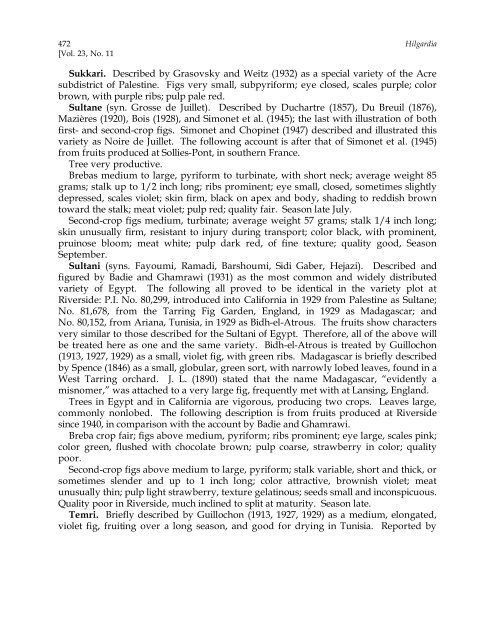Fig Varieties: A Monograph - uri=ucce.ucdavis
Fig Varieties: A Monograph - uri=ucce.ucdavis
Fig Varieties: A Monograph - uri=ucce.ucdavis
Create successful ePaper yourself
Turn your PDF publications into a flip-book with our unique Google optimized e-Paper software.
472 Hilgardia<br />
[Vol. 23, No. 11<br />
Sukkari. Described by Grasovsky and Weitz (1932) as a special variety of the Acre<br />
subdistrict of Palestine. <strong>Fig</strong>s very small, subpyriform; eye closed, scales purple; color<br />
brown, with purple ribs; pulp pale red.<br />
Sultane (syn. Grosse de Juillet). Described by Duchartre (1857), Du Breuil (1876),<br />
Mazières (1920), Bois (1928), and Simonet et al. (1945); the last with illustration of both<br />
first- and second-crop figs. Simonet and Chopinet (1947) described and illustrated this<br />
variety as Noire de Juillet. The following account is after that of Simonet et al. (1945)<br />
from fruits produced at Sollies-Pont, in southern France.<br />
Tree very productive.<br />
Brebas medium to large, pyriform to turbinate, with short neck; average weight 85<br />
grams; stalk up to 1/2 inch long; ribs prominent; eye small, closed, sometimes slightly<br />
depressed, scales violet; skin firm, black on apex and body, shading to reddish brown<br />
toward the stalk; meat violet; pulp red; quality fair. Season late July.<br />
Second-crop figs medium, turbinate; average weight 57 grams; stalk 1/4 inch long;<br />
skin unusually firm, resistant to injury during transport; color black, with prominent,<br />
pruinose bloom; meat white; pulp dark red, of fine texture; quality good, Season<br />
September.<br />
Sultani (syns. Fayoumi, Ramadi, Barshoumi, Sidi Gaber, Hejazi). Described and<br />
figured by Badie and Ghamrawi (1931) as the most common and widely distributed<br />
variety of Egypt. The following all proved to be identical in the variety plot at<br />
Riverside: P.I. No. 80,299, introduced into California in 1929 from Palestine as Sultane;<br />
No. 81,678, from the Tarring <strong>Fig</strong> Garden, England, in 1929 as Madagascar; and<br />
No. 80,152, from Ariana, Tunisia, in 1929 as Bidh-el-Atrous. The fruits show characters<br />
very similar to those described for the Sultani of Egypt. Therefore, all of the above will<br />
be treated here as one and the same variety. Bidh-el-Atrous is treated by Guillochon<br />
(1913, 1927, 1929) as a small, violet fig, with green ribs. Madagascar is briefly described<br />
by Spence (1846) as a small, globular, green sort, with narrowly lobed leaves, found in a<br />
West Tarring orchard. J. L. (1890) stated that the name Madagascar, “evidently a<br />
misnomer,” was attached to a very large fig, frequently met with at Lansing, England.<br />
Trees in Egypt and in California are vigorous, producing two crops. Leaves large,<br />
commonly nonlobed. The following description is from fruits produced at Riverside<br />
since 1940, in comparison with the account by Badie and Ghamrawi.<br />
Breba crop fair; figs above medium, pyriform; ribs prominent; eye large, scales pink;<br />
color green, flushed with chocolate brown; pulp coarse, strawberry in color; quality<br />
poor.<br />
Second-crop figs above medium to large, pyriform; stalk variable, short and thick, or<br />
sometimes slender and up to 1 inch long; color attractive, brownish violet; meat<br />
unusually thin; pulp light strawberry, texture gelatinous; seeds small and inconspicuous.<br />
Quality poor in Riverside, much inclined to split at maturity. Season late.<br />
Temri. Briefly described by Guillochon (1913, 1927, 1929) as a medium, elongated,<br />
violet fig, fruiting over a long season, and good for drying in Tunisia. Reported by
















![Fig Trees in North Carolina [Archive] - IDigMyGarden ... - Figs 4 Fun](https://img.yumpu.com/26905320/1/190x245/fig-trees-in-north-carolina-archive-idigmygarden-figs-4-fun.jpg?quality=85)